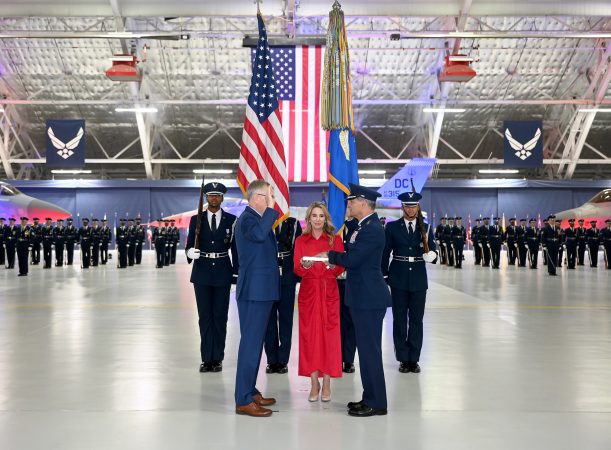JOINT BASE ANDREWS, Md.—Gen. Kenneth S. Wilsbach said the service must improve its readiness in his first public remarks as Air Force Chief of Staff, made during a ceremony marking his ascension to the service’s top job Nov. 18.
“Our Air Force is at a critical juncture,” Wilsbach told attendees, including senior Air Force officers, other service chiefs, and Chairman of Joint Chiefs of Staff Air Force Gen. Dan Caine. “Our main purpose has never changed: we fly and fix to fight and win our nation’s wars.”
Wilsbach has placed a clear emphasis on improving readiness since taking over Nov. 3 from former Chief of Staff Gen. David W. Allvin, who is retiring early after two years in the role. During the ceremony, Wilsbach was sworn in as Chief by Secretary of the Air Force Troy Meink. The ceremony marked Wilsbach’s first foray into public life as Chief, though he has officially carried out the duties for some two weeks after becoming CSAF during the government shutdown.
Wilsbach’s 10-minute remarks during the ceremony reiterated much of the same message he underscored in his opening letter to the force, in which he said the Air Force must “fly, fix, fight”—a phrase repeated by Meink in his remarks inside Andrews’ Hangar 3.
Referencing Operation Midnight Hammer—the June airstrikes on Iranian nuclear facilities that involved some 125 aircraft, including seven B-2 stealth bombers in a well-rehearsed, 36-plus-hour mission spanning the globe—Wilsbach said it was “core responsibility as Airmen to stay ready, be credible and capable every single day.”
“Being able to deliver when called upon demands a constant focus on readiness,” Wilsbach said. “Airmen or aircraft that are not ready to fight undermines our ability to win. Restoring reliability across all aspects of our force, from trained combat formations to better aircraft availability, is vital.”
Wilsbach’s remarks echo comments he made during his Oct. 9 confirmation hearing, when he said the Air Force must fly more—a clear but daunting task for the service, its personnel, and its aircraft. In public comments this year, Wilsbach and Allvin have said that roughly half the Air Force fleet is available on any given day. The average age of the fleet is over 30 years old. Improving readiness will require both money and focus as the service modernizes, a difficult balancing act.
Wilsbach has emphasized readiness in his previous roles as head of Air Combat Command and Pacific Air Forces, overseeing much of the Air Force fleet. But service chiefs bear the ultimate responsibility for training and equipping the nation’s forces, rather than for operationally commanding them.
Meink, too, has said readiness is one of his primary concerns, which he reiterated Nov. 18, and praised Wilsbach’s work in that area, as well as his significant experience in the Pacific as the Air Force attempts to match China’s ever-growing and advancing military.

“He understands the criticality of current readiness on a personal level,” Meink said of Wilsbach. “We must be ready at a moment’s notice to meet the most challenging adversary that we’ve seen in generations. That means our systems need to work—fly, fix, fight.”
There are other concerns facing the Air Force. In addition to improving the current fleet, the Air Force is on a significant and costly modernization campaign, attempting to field the first sixth-generation fighter jet, the F-47, which is set to fly within Wilsbach’s four-year term, and the fielding of the B-21 Raider, the USAF’s next-generation stealth bomber, which is set to enter service during his tenure. The Air Force has also said it will make a production decision next year on its first Collaborative Combat Aircraft—the YFQ-42A and YFQ-44A. On top of new aircraft, the Air Force is facing a vast nuclear modernization effort, including fielding the Sentinel, its costly and likely delayed new intercontinental ballistic missile program.
“We can’t rely on our current weapons alone,” Wilsbach said. “We have to modernize, and our Air Force will constantly lead the way into the future, both modernizing and innovating to stay at the vanguard of combat aviation. Accelerating our acquisition timelines for critical capabilities like the F-47 or Collaborative Combat Aircraft or the B-21 so that they can be employed at the first opportunity will ensure our dominance.”



